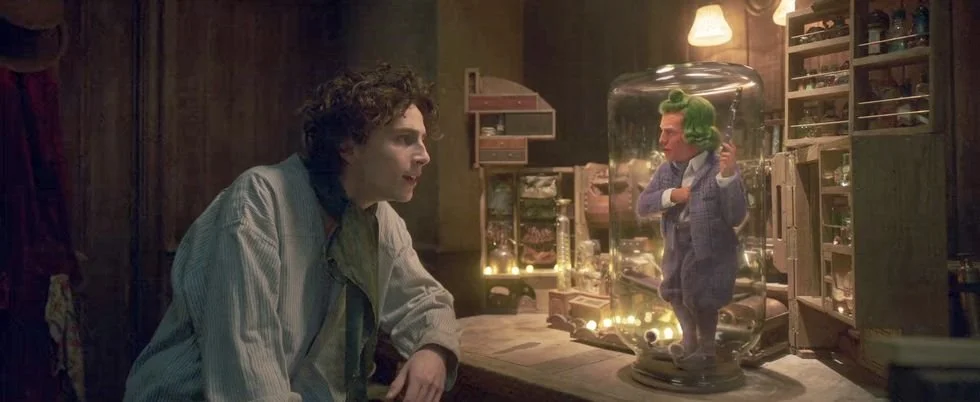ELIO
Directing: B-
Acting: B
Writing: B-
Cinematography: B
Editing: B-
Animation: B+
Elio had its hooks into me from the very beginning. I really thought, until all the alien stuff started happening, that I might love this movie in a way I haven’t loved a Pixar film in a while, since their early days of one animated feature masterpiece after the other.
In retrospect, that was kind of the point. After thirty years of cinema history, Pixar has a playbook, and Elio very much follows it. I could mention who wrote the script, but who has time for that? This movie has nine credited writers. It feels a little like an advanced AI was prompted to “write a Pixar movie.” Opening sequence with overtones of incongruous sadness? Check! Lonely child protagonist who has lost either one or both parents? Check! Eventual non-human buddy for said child designed or optimum merchandising potential? Check!
Maybe I’ve just gotten old and cynical, but unfortunately, Pixar is feeling its age a bit as well. I was charmed well enough by Elio, but I could also see that it worked because of a well-worn and successful formula. The story is permeated by layers of familiarity. Pixar is supposed to be pushing the boundaries of the form, but Elio often feels like a cross between E.T. and Finding Nemo, at least in terms of its world-building.
Don’t get me wrong. Small children will almost certainly love this movie. Not that small children have standards. I long for the days of Pixar’s revolutionary depth of sophistication, both visual and thematic. WALL-E (2008) or Inside Out (2015), this is not. This is more on par with Onward (2020) or Luca (2021), more recent titles that push Pixar closer to the realm of “generic.” Elio is certainly flashier than those other recent films, and as such will probably dazzle kids more successfully, with its alien characters that are wildly varied, in both physical form and personality.
There’s still something missing, though, a certain depth of imagination. The visuals here are rendered well, but they take sometimes surprisingly rudimentary form. When Elio is sucked through a portal from earth by the aliens he so desperately wants to be abducted by, the tunnel of shifting lights and forms he glides through are patterns of simple goemetric shapes.
Elio begins with a huge amount of potential—even as it recognizably tugs at our heartstrings, introducing us to his aunt, Olga (Zoe Saldaña), who is still getting used to taking care of Elio (Yonas Kibreab) after the death of his parents. Olga being too busy with work to pay enough attention to him, and Elio’s deep loneliness and difficulty connecting, is all very familiar territory. But then we find out he is obsessed with connecting with life on other planets, and in particular the Voyager 1, which was launched in 1977 and equipped with a “Golden Record,” pressed with greetings in many languages from Earth.
Both Voyager 1 and the Golden Record figure prominently in the plot of Elio, which is easy to imagine catching the attention of anyone with an obsession with the intersection of science and history. Elio lends these artifacts appropriate thematic weight—until it doesn’t. In the end, these things are just used as plot devices for something . . . cute. If it ignites interest in any other kids in these artifacts, I suppose that’s a plus. But the story of Elio takes everything predictably back to themes of familial connection, using alien characters, half of which look like exotic sea creatures and half of which look like robots, as the vessel.
Elio himself is a delightful, charming, and deeply empathetic character, voiced well by Yonas Kibreab and rendered with visual nuance. The same goes for Olga, and the arc of these two, disconnected and then finding each other, was indeed something that moved me. I even got teary-eyed a couple of times. A formula that works is still a formula, and it’s the trappings that really make all the difference in greatness. Once aliens hear Elio’s call to come and get him, Elio spends much more time on standard cuteness than on anything truly meaningful.
Perhaps I ask too much of this movie. Indeed, not every movie has to mean something. My issue here is that Pixar spent years setting an industry standard, and now other studios are meeting that standard more than they do. It makes me sad. For the most part, Elio works—but, it works as a fairly generic entertainment, one that no one will be talking about generations from now, certainly not like they do with Toy Story or Finding Nemo or even Inside Out (all of which got boosts from sequels, granted—but good ones, all of them better than Elio).
I am constantly saying a movie should be judged on its own terms. That’s just the trouble with Elio, though: none of its terms are really its own. It’s a Frankenstein of Pixar films, stitched from previously used elements that saw better days in their previous lives. I had a pretty good time watching it, I smiled a lot, I suppose that counts for something. I’m also going to post this review and then get on with my life without ever really thinking about this movie again.
We know how to have fun, right?
Overall: B-










